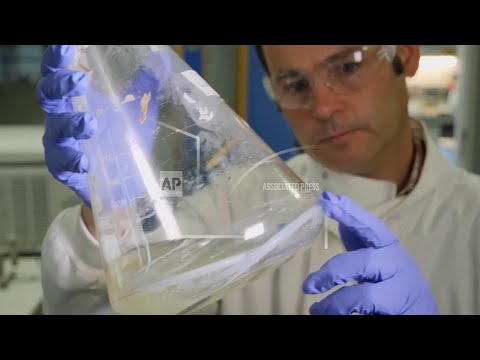(18 Jun 2025)
ASSOCIATED PRESS
ARCHIVE: Nottingham, UK – 18 May 2018
1. Various of machine with flask containing catheter in a solution
2. View from inside an incubator window of researcher opening the door and reaching in to take out a Petri dish with growing bacteria
3. Mid of researcher looking at bacteria
4. View from inside an incubator window of researcher replacing dish inside
5. Wide of researcher closing door and walking to machine and removing flask
6. Close of researcher holding and looking at flask
7. Various close of bacteria growing on catheter in flask
ASSOCIATED PRESS
Nottingham, UK – 17 June 2025
VIDEO CALL
8. SOUNDBITE: (English) Paul Williams Emeritus Professor of molecular microbiology University of Nottingham
"They (bacteria) envelop themselves in a sticky, gluey, matrix, which makes them quite resistant to – in a stream it could be amoeba – in our human body it’s the immune system. But also it’s a survival mechanism of biofilm. And so biofilms are much more tolerant to antibiotics. So if you have a biofilm on your medical device in your patient is extremely difficult to eradicate unless often you just have to remove the device, which means it’s no longer working for the benefit of that patient. So it’s a lifestyle bacteria adopts which is a survival lifestyle where they’re living together in a sticky matrix, slimy community, if you like."
ASSOCIATED PRESS
ARCHIVE: Nottingham, UK – 18 May 2018
9. Close of slides being held in tweezers
10. Various of researcher putting slide into microscope
11. Close of lid of microscope being closed
12. Wide of researcher
13. Close of computer monitor showing magnified bacteria moving around slide
14. Pull focus from researcher to computer monitor showing bacteria
15. Mid of researcher looking at slides
ASSOCIATED PRESS
Nottingham, UK – 17 June 2025
VIDEO CALL
16. SOUNDBITE: (English) Paul Williams Professor of molecular microbiology University of Nottingham
"The patterns are made of things called primitives, which are basically, if you think about them as pyramid spheres and cubes and you can put those together in different ways to create a different shape, which we call a feature. And then you can arrange the features, on a flat surface. So the features can be a certain height, they can be a certain size and they can create channels larger or smaller distances between them. And so if you have thousands of these, you need a machine learning approach to figure out which ones might give you the output that you want."
ASSOCIATED PRESS
ARCHIVE Nottingham, UK – 18 May 2018
17. Various close of video on computer showing bacteria ‘swarming’ getting elongated as they spread and colonise the surface
ASSOCIATED PRESS
Nottingham, UK – 17 June 2025
VIDEO CALL
18. SOUNDBITE: (English) Paul Williams Professor of molecular microbiology University of Nottingham
"It’s very resistant to antimicrobial agents. It’s a real tough so and so and so. It’s one of the World Health Organization, organisms, of concern. So it’s one of the ESKAPE pathogens and it basically can cause infections in any body sites. Normally it would prefer to attack an immune compromised person."
ASSOCIATED PRESS
ARCHIVE: Nottingham, UK – 18 May 2018
19. Various close of video on computer showing how bacteria cannot swarm and spread over polymer treated surface with a couple of organisms getting separated
ASSOCIATED PRESS
Nottingham, UK – 17 June 2025
VIDEO CALL
20. SOUNDBITE: (English) Paul Williams Professor of molecular microbiology University of Nottingham
ASSOCIATED PRESS
23. Close of catheter
Find out more about AP Archive: http://www.aparchive.com/HowWeWork
Twitter: https://twitter.com/AP_Archive
Facebook: https://www.facebook.com/APArchives
Instagram: https://www.instagram.com/APNews/
You can license this story through AP Archive: http://www.aparchive.com/metadata/youtube/dcbdfffae8794c1ca64e27608f39c96b
Author: AP Archive
Go to Source
News post in June 23, 2025, 3:05 pm.
Visit Our Sponsor’s:
News Post In – News





